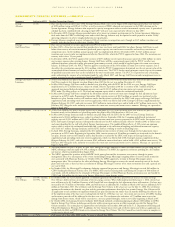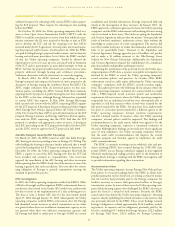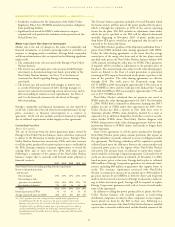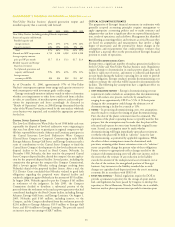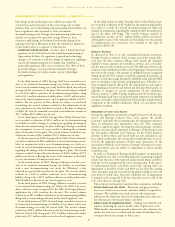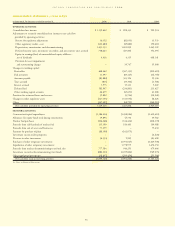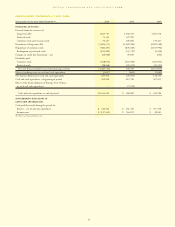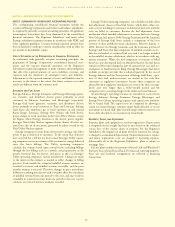Entergy 2006 Annual Report Download - page 63
Download and view the complete annual report
Please find page 63 of the 2006 Entergy annual report below. You can navigate through the pages in the report by either clicking on the pages listed below, or by using the keyword search tool below to find specific information within the annual report.
ENTERGY CORPORATION AND SUBSIDIARIES 2
2000066
Costs and Funding
In 2006, Entergy’s total qualified pension cost was $131 million.
Entergy anticipates 2007 qualified pension cost to decrease to $128
million (including Entergy New Orleans’ cost of $2.8 million) due to
an increase in the discount rate (from 5.90% to 6.00%) and 2006
actual return on plan assets greater than 8.5%. Pension funding was
$318 million for 2006, including the 2005 contribution of $107 mil-
lion that was delayed until 2006 as a result of the Katrina Emergency
Tax Relief Act. Entergy’s contributions to the pension trusts are pro-
jected to be $176 million in 2007, including Entergy New Orleans’
contribution of $44 million.
The Pension Protection Act of 2006 was signed by the President on
August 17, 2006. The intent of the legislation is to require companies
to fund 100% of their pension liability; and then for companies to
fund, on a going-forward basis, an amount generally estimated to be
the amount that the pension liability increases each year due to an
additional year of service by the employees eligible for pension bene-
fits. The legislation requires that funding shortfalls be eliminated by
companies over a seven-year period, beginning in 2008. The Pension
Protection Act also extended the provisions of the Pension Funding
Equity Act that would have expired in 2006 had the Pension
Protection Act not been enacted, which increased the allowed dis-
count rate used to calculate the pension funding liability.
Total postretirement health care and life insurance benefit costs for
Entergy in 2006 were $90 million, including $28 million in savings
due to the estimated effect of future Medicare Part D subsidies.
Entergy expects 2007 postretirement health care and life insurance
benefit costs to be $88 million (including Entergy New Orleans’ costs
of $5 million). This includes a projected $26 million in savings due
to the estimated effect of future Medicare Part D subsidies. The
decrease in postretirement health care and life insurance benefit costs
is due to the increase in the discount rate (from 5.9% to 6.00%) and
plan amendments in the Non-Utility Nuclear plans.
OTHER CONTINGENCIES
As a company with multi-state domestic utility operations and a his-
tory of international investments, Entergy is subject to a number of
federal, state, and international laws and regulations and other factors
and conditions in the areas in which it operates, which potentially
subject it to environmental, litigation, and other risks. Entergy peri-
odically evaluates its exposure for such risks and records a reserve for
those matters which are considered probable and estimable in accor-
dance with generally accepted accounting principles.
Environmental
Entergy must comply with environmental laws and regulations appli-
cable to the handling and disposal of hazardous waste. Under these
various laws and regulations, Entergy could incur substantial costs to
restore properties consistent with the various standards. Entergy con-
ducts studies to determine the extent of any required remediation and
has recorded reserves based upon its evaluation of the likelihood of
loss and expected dollar amount for each issue. Additional sites could
be identified which require environmental remediation for which
Entergy could be liable. The amounts of environmental reserves
recorded can be significantly affected by the following external events
or conditions:
■Changes to existing state or federal regulation by governmental
authorities having jurisdiction over air quality, water quality,
control of toxic substances and hazardous and solid wastes, and
other environmental matters.
■The identification of additional sites or the filing of other
complaints in which Entergy may be asserted to be a potentially
responsible party.
■The resolution or progression of existing matters through the
court system or resolution by the EPA.
Litigation
Entergy has been named as defendant in a number of lawsuits involv-
ing employment, ratepayer, and injuries and damages issues, among
other matters. Entergy periodically reviews the cases in which it has
been named as defendant and assesses the likelihood of loss in each
case as probable, reasonably estimable, or remote and records reserves
for cases which have a probable likelihood of loss and can be estimat-
ed. Notes 2 and 8 to the financial statements include more detail on
ratepayer and other lawsuits and management’s assessment of the ade-
quacy of reserves recorded for these matters. Given the environment
in which Entergy operates, and the unpredictable nature of many of
the cases in which Entergy is named as a defendant, however, the ulti-
mate outcome of the litigation Entergy is exposed to has the potential
to materially affect the results of operations of Entergy, or its operat-
ing company subsidiaries.
Sales Warranty and Tax Reserves
Entergy’s operations, including acquisitions and divestitures, require
Entergy to evaluate risks such as the potential tax effects of a transac-
tion, or warranties made in connection with such a transaction.
Entergy believes that it has adequately assessed and provided for these
types of risks, where applicable. Any reserves recorded for these types
of issues, however, could be significantly affected by events such as
claims made by third parties under warranties, additional transactions
contemplated by Entergy, or completion of reviews of the tax treat-
ment of certain transactions or issues by taxing authorities. Tax
reserves not expected to reverse within the next year are reflected as
non-current taxes accrued in the financial statements. Entergy does
not expect a material adverse effect on earnings from these matters.
NEW ACCOUNTING PRONOUNCEMENTS
FASB Interpretation No. 48, “Accounting for Uncertainty in Income
Taxes” (FIN 48) was issued in July 2006 and is effective for Entergy
in the first quarter of 2007. FIN 48 establishes a “more-likely-than-
not” recognition threshold that must be met before a tax benefit can
be recognized in the financial statements. If a tax deduction is taken
on a tax return, but does not meet the more-likely-than-not recogni-
tion threshold, an increase in income tax liability, above what is
payable on the tax return, is required to be recorded. Additional dis-
closure in the footnotes to the financial statements will also be
required for such liabilities. Entergy does not expect that the adoption
of FIN 48 will materially affect its financial position, results of oper-
ations, or cash flows. Entergy expects that the cumulative effect of the
adoption of FIN 48 will result in a reduction to consolidated retained
earnings at January 1, 2007 in the range of $3 million to $5 million.
In September 2006 the FASB issued Statement of Financial
Accounting Standards No. 157, "Fair Value Measurements" (SFAS
157) which defines fair value, establishes a framework for measuring
fair value in GAAP, and expands disclosures about fair value measure-
ments. SFAS 157 generally does not require any new fair value
measurements. However, in some cases, the application of SFAS 157
in the future may change Entergy’s practice for measuring and disclos-
ing fair values under other accounting pronouncements that require
or permit fair value measurements. SFAS 157 is effective for Entergy
in the first quarter of 2008 and will be applied prospectively. Entergy
is currently evaluating SFAS 157 and its potential future impacts on
its financial position, results of operations, and cash flows.
In February 2007 the FASB issued Statement of Financial
Accounting Standards No. 159, “The Fair Value Option for Financial
Assets and Financial Liabilities” (SFAS 159), which permits entities to
choose to measure many financial instruments and certain other items
at fair value. SFAS 159 is effective for Entergy in the first quarter
2008, and because SFAS 159 was recently issued Entergy's evaluation
is in its initial stages.
MANAGEMENT’S FINANCIAL DISCUSSION and ANALYSIS concluded
47


